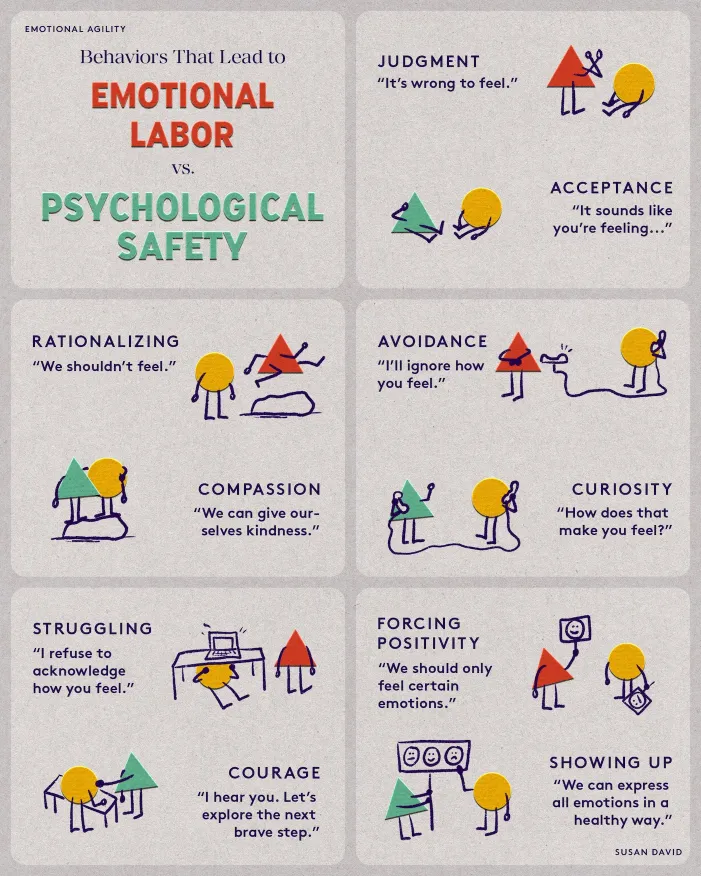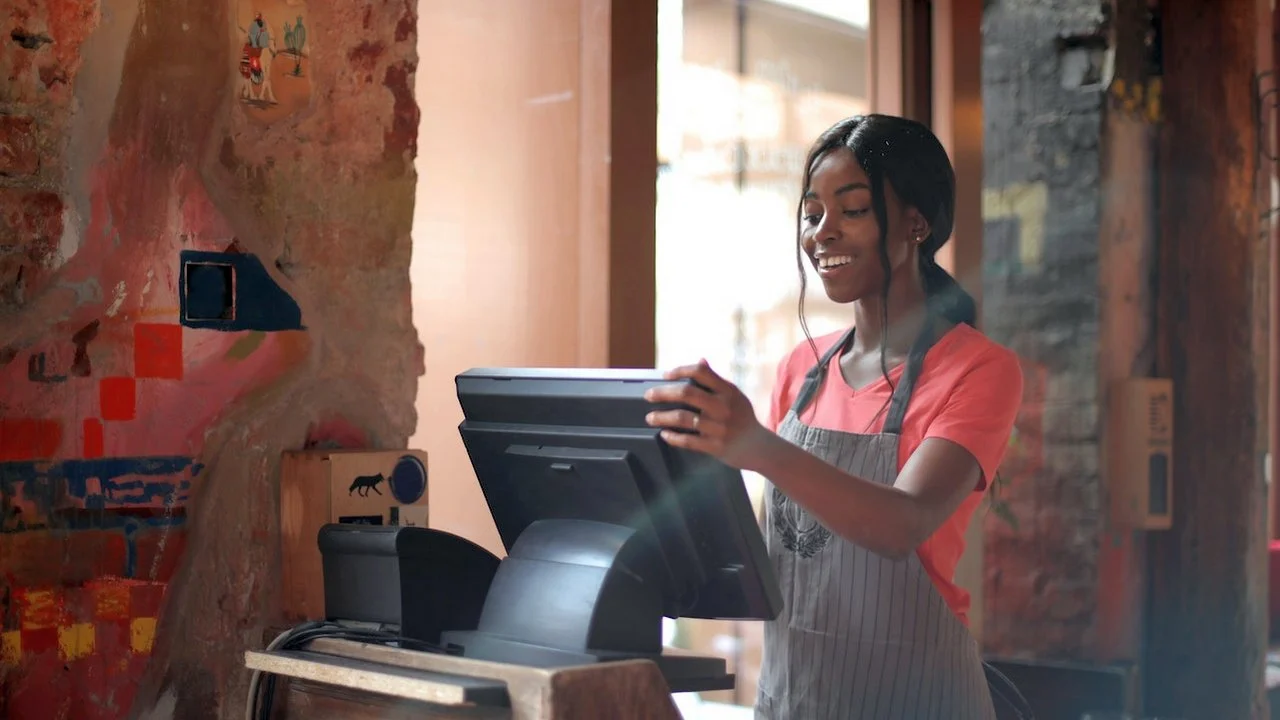Today's Thursday • 8 mins read
Psychological safety is the freedom to speak up, try ideas, or take risks without fear of being punished, retributed, or humiliated.
“Psychological safety isn’t about being soft. It’s about making it OK for people to say what they think, without being scared of getting yelled at or shut down.” — Kate Bernal
There are four stages of psychological safety that organizations can work towards achieving.
4 Stages of Psychological Safety
Timothy Clark’s research found there are four stages of psychological safety: inclusion safety, learner safety, contributor safety, and challenger safety.
Stage 1: Inclusion Safety
- The first stage of psychological safety is inclusion safety. In this stage, team members feel safe to be themselves and feel included in the group.
- Employees feel that they are part of the team and that their contributions are valued. This can be achieved by providing opportunities for employees to collaborate and share their ideas.
- They believe that their perspectives and opinions are valued and that they belong in the team. This stage is critical for building trust among team members and creating a foundation for psychological safety.
Stage 2: Learner Safety
- The second stage of psychological safety is learner safety. In this stage, team members feel safe to ask questions, admit mistakes, and learn from each other.
- Employees feel safe to ask questions and admit their mistakes. This creates a culture of continuous learning and improvement.
- They recognize that they don’t have all the answers and are open to feedback and constructive criticism. This stage is critical for fostering a culture of continuous learning and improvement.
Stage 3: Contributor Safety
- The third stage of psychological safety is contributor safety. In this stage, team members feel safe to share their ideas and opinions without fear of negative consequences.
- Employees feel empowered to contribute their ideas and take ownership of their work. This can be achieved by providing autonomy and recognizing employees for their contributions.
- They believe that their contributions are valued and that they have a voice in the decision-making process. This stage is critical for promoting innovation and creativity within the team.
Stage 4: Challenger Safety
- The final stage of psychological safety is challenger safety. In this stage, team members feel safe to challenge the status quo and take risks.
- Employees feel safe to challenge the status quo and suggest new ideas. This can be achieved by encouraging healthy debate and recognizing the value of diverse perspectives.
- They recognize that innovation requires taking calculated risks and are willing to speak up when they see an opportunity for improvement. This stage is critical for promoting a culture of innovation and driving progress within the team. Psychological safety, once established, can lead to increased innovation, creativity, and productivity within the team.
7 Leadership Roles In Building Psychological Safety
Susan David, PhD, says, “When we encourage authenticity and embrace each other as human first, we create a space in which everyone feels free to feel the way they feel. We create a culture of psychological safety.”

It is the duty of the leaders to help build and maintain psychological safety in the workplace. These are some ways they can do so:
- Positive Management Practices: Fostering open communication, 360° feedback, discussing employee well-being, recognizing/rewarding contributions, encouraging professional growth, and creating an inclusive work environment. A CEO can regularly start company meetings that every employee’s voice matters.
- Safe Environment: Leaders who focus on psychological safety enable employees to speak up, share ideas, and make mistakes without fear of retribution. Example: A manager can implement regular check-ins with team members to discuss their well-being and work-life balance.
- Culture of Innovation: This safe environment encourages employees to take risks and try new things, leading to greater innovation. Example: A team can be encouraged to brainstorm new product ideas or workflow processes, without playing down any suggestion at the ideation stage.
- Modeling Vulnerability: Leaders can open up about their mistakes and failed experiments, to foster psychological safety in the employees. Example: A leader can share a personal story about a past failure and what they learned from it, encouraging team members to share their experiences without fear of criticism.
- Building Trust and Community: Openness from leaders fosters trust and strengthens the sense of community within the workplace. Example: A manager can organize team-building activities that promote open communication and collaboration, helping employees feel more connected to one another.
- Response to Feedback: How leaders respond to feedback is critical; defensiveness can create fear, while openness promotes growth and improvement. Example: After receiving constructive criticism about a project, a leader can thank the team for their inputs and discuss how they can implement the feedback to improve future work.
- Initiative for Trust and Respect: Leaders must actively cultivate a culture of mutual trust and respect, especially when a team is facing challenges. Example: A team-leader can establish a “no blame” policy, where mistakes are considered learning opportunities, encouraging team members to support each other in solving challenges.
Psychological Safety As “Trickle Effect”
A culture of psychological safety is often a trickle-down effect from the leaders and bosses. The ones on the top need to model the behavior they want to see. They must take steps to make employees feel safe enough to be vulnerable and authentic.
The definition of trickle effect is “a process whereby perceptions, feelings, attitudes, or behaviors of a source affect perceptions, feelings, attitudes, or behaviors of a transmitter.”
5 different types of trickle effects:
- Trickle-Down Effect: When behaviors, attitudes, or policies from higher levels of an organization influence those at lower levels.
- Trickle-Up Effect: The reverse of the trickle-down effect, where insights, behaviors, or attitudes from lower levels of an organization influence those at higher levels.
- Trickle-Out Effect: Where behaviors or attitudes spread from an organization to external stakeholders, such as customers, suppliers, or the broader community.
- Trickle-In Effect: This is external influences or trends permeate an organization from the outside in.
- Trickle-Around Effect: The diffusion of behaviors or attitudes laterally among peers within the same level of an organization.

Promoting Inclusion and Diversity
A psychologically safe workplace is one where employees feel included, valued, and respected. Inclusion and diversity are crucial to creating a psychologically safe workplace.
- Diversity refers to the differences among people in the workplace – differences in race, ethnicity, gender, sexual orientation, religion, age, etc.
- Inclusion is the act of creating an environment where all employees feel valued and respected, regardless of their differences.
Organizations can take these steps to promote inclusion and diversity:
- Developing and implementing diversity and inclusion policies and training programs.
- Encouraging open communication and dialogue among all employees.
- Providing opportunities for employees to learn about and celebrate different cultures and perspectives.
- Ensuring that all employees have access to the same opportunities for advancement and professional development.
- Creating a workplace culture that values and respects all employees, regardless of their differences.
- Diversifying the workplace by hiring employees from different backgrounds and experiences.
Encouraging Innovation and Creativity
Encouraging employees to think outside the box and challenge the status quo can lead to breakthrough ideas and solutions.
According to Google’s Project Aristotle, psychological safety is the most important factor in creating high-performing teams.
“Project Aristotle shows that the best teams at Google exhibit a range of soft skills: equality, generosity, curiosity toward the ideas of your teammates, empathy, and emotional intelligence. And topping the list: emotional safety. No bullying. To succeed, each and every team member must feel confident speaking up and making mistakes. They must know they are being heard.”
— The Washington Post
To encourage innovation and creativity, organizations must create a psychologically safe environment.
Leveraging Conflict for Growth
Conflict is often viewed as a negative force that can harm team dynamics and productivity. However, when managed effectively, dispute can actually be leveraged for growth and innovation.
This is where psychological safety comes into play. According to a study by Edmondson and Lei (2014), psychological safety is defined as “a shared belief held by members of a team that the team is safe for interpersonal risk-taking.”
When team members feel psychologically safe, they are more likely to engage in:
- Constructive dissent — expressing their opinions and ideas, even if they go against the majority.
- Creative abrasion — engaging in productive debate and challenging each other’s assumptions.
- Intellectual friction — rigorously debating and critiquing each other’s ideas and suggestions.
Final Words
- The first mentions of psychological safety trace back to 1965, when Edgar Schein and Warren Bennis noted that it was essential for making people feel secure and capable of changing.
- Schein later discussed psychological safety for helping people focus on achieving shared goals, and solving problems without excessive self-protection or defensiveness.
- William Kahn (1990) brought psychological safety into the modern era with a qualitative study of a summer camp and an architecture firm, connecting psychological safety to engagement.
Today, psychological safety has become a non-dispensable part of company policies.
√ Also Read: Fundamental Attribution Error – 6 Crucial Questions Answered
√ Please spread the word if you found this helpful.
» You deserve happiness! Choosing therapy could be your best decision.
...
• Disclosure: Buying via our links earns us a small commission.